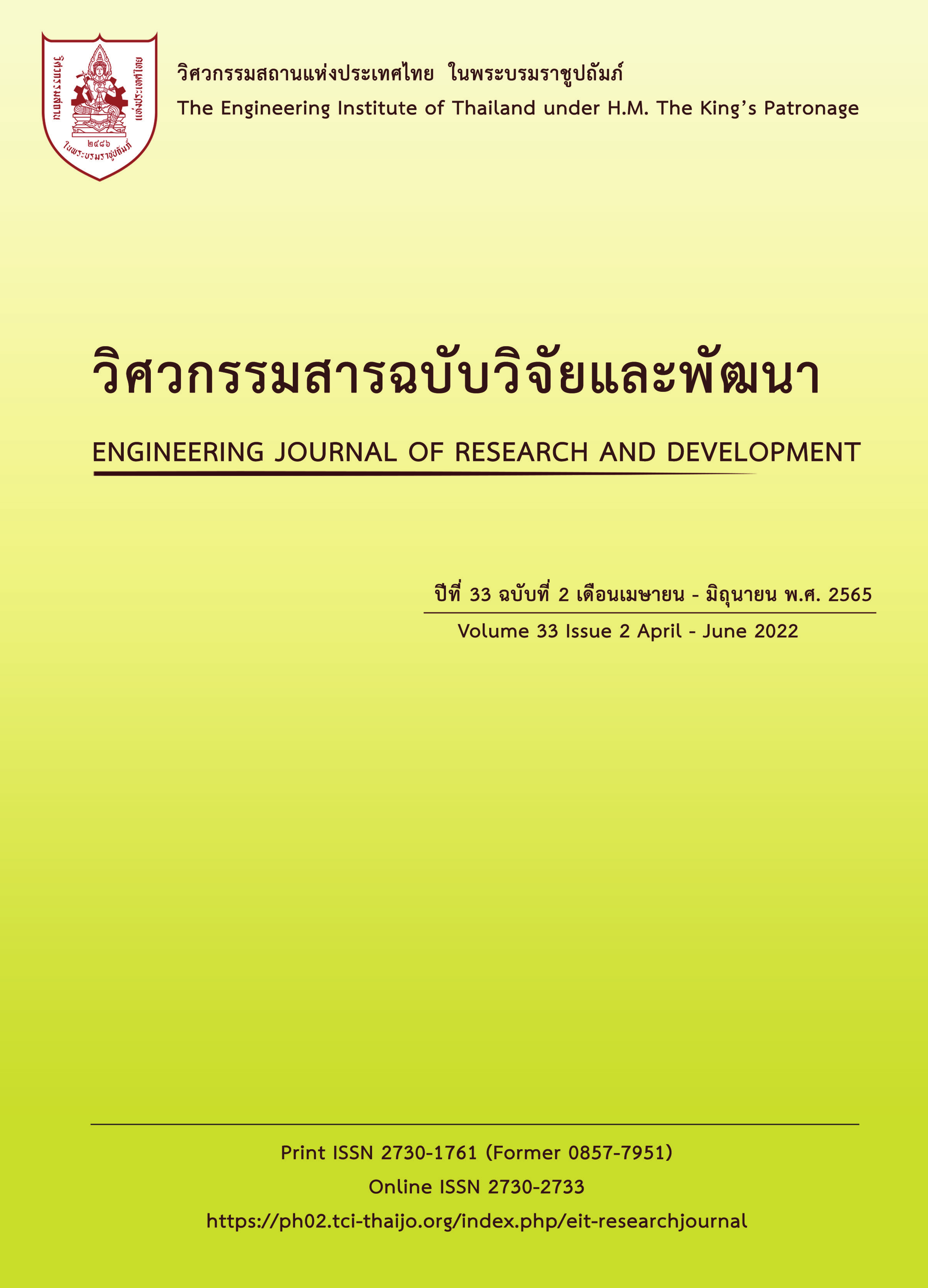THE BEHAVIOR OF DIAPHRAGM WALL IN BANGKOK USING FINITE ELEMENT SIMUMATION
Main Article Content
Abstract
This research is mainly focused on the behavior of diaphragm wall in Bangkok area using finite element model simulation with various wall thickness and length. The 2-D FEM model had been generated for each stage of bottom-up construction and excavation depth ranging from 3 to 18 m. The Mohr-Coulomb model is assigned for soil foundation and Young’s modulus of clay layers is 350su and 500su. The results show that the minimum wall length that can support the underground construction depends on excavation depth and wall thickness. The observed D-wall model behavior could be divided into 2 types according to the wall movement. These include Free-End Behavior and Restrain-End Behavior. The retaining wall length that divided between these behaviors is between 21 and 27 m, and depends on excavation depth and wall thickness. The wall movement behavior also influences the total horizontal stress acting on the wall, reaction force of strut, induced shear force and moment of the wall. Finally, the D-wall construction charts in Bangkok subsoil had been developed for an estimation of maximum wall movement, maximum shear force and maximum moment in the wall.and ground surface deformation.
Article Details

This work is licensed under a Creative Commons Attribution-NonCommercial-NoDerivatives 4.0 International License.
The published articles are copyright of the Engineering Journal of Research and Development, The Engineering Institute of Thailand Under H.M. The King's Patronage (EIT).
References
ประลองยุทธ์ กสิวงศ์, ผลกระทบของการเจาะอุโมงค์ผ่านสถานีรัชดาต่อการเคลื่อนตัวของดินและกำแพงสถานี. วิทยานิพนธ์ปริญญาวิศวกรรม ศาสตรมหาบัณฑิต คณะวิศวกรรมศาสตร์ จุฬาลงกรณ์มหาวิทยาลัย, 2545.
ภัทราวุธ อาวจำปา, กำแพงไดอะแฟรมในการขุดดินลึกในเขตปลอดภัยของสถานีรถไฟฟ้าใต้ดิน. วิทยานิพนธ์ปริญญาวิศวกรรมศาสตร มหาบัณฑิต คณะวิศวกรรมศาสตร์ จุฬาลงกรณ์มหาวิทยาลัย, 2551.
Teparaksa, W., Thasnanipan, N. and Tanseng, P. Analysis of lateral wall movement for deep braced excavation in Bangkok subsoils. In: Proceeding of the Civil and Environmental Engineering Conference, Bangkok, Thailand, November 1999, pp. 67-76.
Teparaksa, W. and Teparaksa, J. Comparison of diaphragm wall movement prediction and field performance for different construction techniques. Underground Space, 2019, 4 (3), pp.225-234.
ธีรพงษ์ แพนเกาะ, พฤติกรรมของกำแพงกันดินไดอะแฟรมวอลล์สำหรับงานขุดลึกในดินเหนียวกรุงเทพ. วิทยานิพนธ์ปริญญาวิศวกรรมศาสตร มหาบัณฑิต คณะวิศวกรรมศาสตร์ จุฬาลงกรณ์มหาวิทยาลัย, 2548.
พงษ์พินันท์ บูรณะกิติ, พฤติกรรมการเคลื่อนตัวของกำแพงกันดินชนิดเข็มพืดและไดอะแฟรมสำหรับงานขุดแบบใช้ค้ำยันในดินเหนียวกรุงเทพ. วิทยานิพนธ์ปริญญาวิศวกรรมศาสตรมหาบัณฑิต คณะวิศวกรรมศาสตร์ จุฬาลงกรณ์มหาวิทยาลัย, 2548.
วันปิยะ สานุกูล, พฤติกรรมดินเหนียวอ่อนกรุงเทพมหานครในงานขุดดินและพารามิเตอร์สำหรับการวิเคราะห์ด้วยระเบียบวิธีไฟไนต์อิลิเมนต์. วิทยานิพนธ์ปริญญาวิศวกรรมศาสตรมหาบัณฑิต คณะวิศวกรรมศาสตร์ จุฬาลงกรณ์มหาวิทยาลัย, 2556.
Likitlersuang, S., Surarak, C., Wanatowski, D., Oh, E. and Balasubramaniam, A. Finite element analysis of a deep excavation: A case study from the Bangkok MRT. Soils and foundations, 2013, 53 (5), pp. 756-773.
เอกพิศิษฐ์ จันทร์ทอง, การจำลองพฤติกรรมการเคลื่อนตัวของดินและไดอะแฟรมวอลล์ที่ก่อสร้างในพื้นที่กรุงเทพมหานครด้วยไฟไนท์อิลิเมนท์. วิทยานิพนธ์ปริญญาวิศวกรรมศาสตรมหาบัณฑิต คณะวิศวกรรมศาสตร์ มหาวิทยาลัยเกษตรศาสตร์, 2564.
Faheem, H., Cai, F. and Ugai, K. Three-dimensional base stability of rectangular excavations in soft soils using FEM. Computers and Geotechnics, 2004, 31 (2), pp. 67-74.
Likitlersuang, S., Chheng, C. and Keawsawasvong, S. Structural modelling in finite element analysis of deep excavation. Journal of GeoEngineering, 2019, 14 (3), pp. 121-128.
Hsiung, B. C. B., Likitlersuang, S., Phan, K. H. and Pisitsopon, P. Impacts of the plane strain ratio on excavations in soft alluvium deposits. Acta Geotechnica, 2021, 16 (6), pp. 1923-1938.
เชิดพันธุ์ อมรกุล, ฐานข้อมูลชั้นดินทางวิศวกรรมบริเวณที่ราบภาคกลางตอนล่างของประเทศไทย. วิทยานิพนธ์ปริญญาวิศวกรรมศาสตร มหาบัณฑิต คณะวิศวกรรมศาสตร์ มหาวิทยาลัยเกษตรศาสตร์, 2553.
ชินวุฒิ ชาญฉายา, การวิเคราะห์การเคลื่อนตัวของชั้นดินกรุงเทพฯ เนื่องจากการก่อสร้างอุโมงค์รถไฟฟ้าใต้ดินโดยวิธีแบบจำลองทางคณิตศาสตร์. วิทยานิพนธ์ปริญญาวิศวกรรมศาสตรมหาบัณฑิต คณะวิศวกรรมศาสตร์ จุฬาลงกรณ์มหาวิทยาลัย, 2543.
Phien-wej, N., Giao, P. H. and Nutalaya, P. Land subsidence in Bangkok, Thailand. Engineering geology, 2006, 82 (4), pp. 187-201.
Saowiang, K. and Giao, P. H. Numerical analysis of subsurface deformation induced by groundwater level changes in the Bangkok aquifer system. Acta Geotechnica, 2021, 16 (4), pp. 1265-1279.


